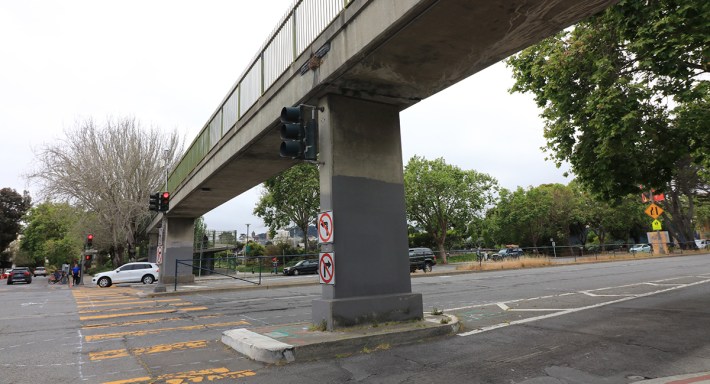Streetsblog hopes readers will find a way to get a nice bike ride or a walk in during this weird, social-distancing, shelter-in-place, Memorial Day Weekend. In the meantime, here are a few shorties to kick off the break:
Oakland expands 'slow streets,' adds 'essential places'

Oakland is steaming ahead with the 'slow streets' program, now up to 20 miles on 17 different corridors distributed throughout the city.
They're also making an adjustment, so that 'slow streets' treatments can help residents get groceries and other essential supplies and services. From the OakDOT release:
The City of Oakland and community partners will announce Friday a new tool in the Oakland Slow Streets toolbox: Essential Places, where Slow Streets’ temporary traffic safety improvements will be installed to enable safer access for residents to the essential services in their neighborhood – including grocery stores, food distribution sites in public facilities, and COVID-19 test sites. This new iteration of Slow Streets installations is responsive to community feedback, especially from groups organized in East Oakland, highlighting the need for safer access to essential services in each neighborhood.
Good riddance, Geary/Steiner Ped Bridge:

It was always about the cars. The pedestrian bridge built over Geary Street at Steiner never had anything to do with pedestrian safety. It's a throwback to the bad old days of auto-über alles policies. And Geary, which was redesigned in the 1960s to be a ground-level freeway--well, the city couldn't have those pesky elderly walkers crossing the road, forcing motorists to drive at safe speeds through a populated city. So they built a pedestrian bridge to get them out of the way.
That's all going to change, starting this weekend.
From SFMTA's release:
While removing the overpass may sound like a bridge too far, in this case it’s a bridge too steep. The Steiner pedestrian bridge was built in 1962, with 11-17 percent ramp slopes that far exceed the 5 percent limit that was later established by the Americans with Disabilities Act. The bridge’s support piers also reduce visibility of people crossing at the intersection. In place of the overpass, the SFMTA will be improving conditions for how people already prefer to travel—currently, over 80 percent of people on foot or wheelchair cross Geary and Steiner at street level.
Goodbye and good riddance. See lead image for how it will look in the future.
And lastly, advocates push for even more 'slow streets' in San Francisco.

San Francisco and Oakland's 'slow streets' programs have been accelerated by the dedicated efforts of local advocates (as well as professional advocacy groups). They are setting up petitions and otherwise pushing for more space for people to exercise and socially distance safely. Most recently, advocate Michael Chen with the group Northern Neighbors started a petition for more 'slow streets' in San Francisco's District 2.
From his petition post on Medium:
We are excited that Lake Street in District 2 is now a slow street, stretching for over a mile from Arguello Boulevard to 28th Avenue. We appreciate that the SFMTA is diligently working to identify, perform outreach for, and install slow streets. But we’d like to imagine bigger and better: not just one or two slow streets in District 2, but an entire network of streets where people can exercise and safely travel to essential businesses.
He's urging people to take the District 2 'slow streets' survey, available here. "This information will be shared with neighborhood groups, District 2 Supervisor Catherine Stefani, and SFMTA," he wrote in the post.
Meanwhile, advocate Mary Kay Chin of the Yellow Bike Project is asking the city to focus more on adding 'slow streets' on high-injury corridors, especially in the Tenderloin, where there is none currently. "A quick view of the geographic distribution of the newly transformed streets reveals that site selection was not guided by the City’s own public safety data," wrote Chin, in an email to Streetsblog. "These high injury corridors were not given priority to receive the Slow Street treatment." Walk San Francisco agrees: "...the neighborhoods that are in critical need of sidewalk space – the Tenderloin and Chinatown – are sorely missing" the group's Jodie Medeiros wrote in a post.
The S.F. Bicycle Coalition has set up a petition as well, also urging 'slow streets' in the Tenderloin.
SFMTA hasn't announced any immediate plans to add one, but a spokesperson wrote that the agency "...is working very hard on the program."





